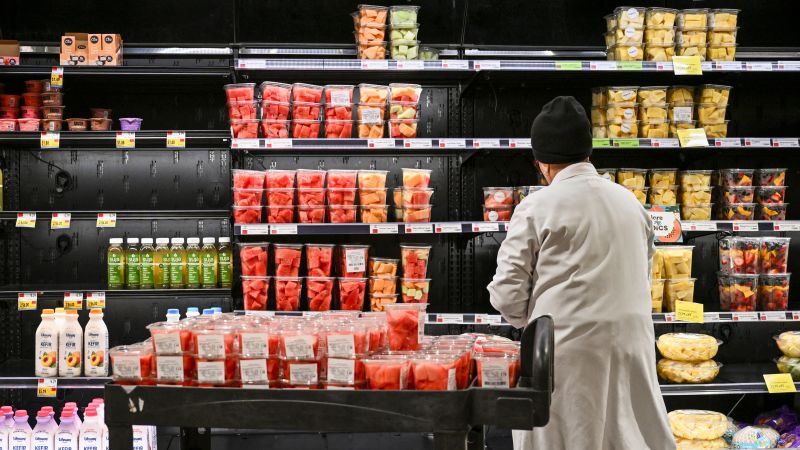CNN
—
Inflation slowed sharply in March, new data showed Thursday, underscoring the continued strength and resilience of the economy ahead of President Trump’s aggressive trade moves.
In any other timeline, such news would stoke optimism that Americans’ cost of living is no longer surging.
Instead, Thursday’s Consumer Price Index report was likely another example of a ‘what might have been’ for the US economy.
The latest reading of the Consumer Price Index — which showed inflation sharply cooling to an annual rate of 2.4% in March from 2.8% in February — lands as countries, businesses, markets and consumers grapple with America’s most severe escalation of its tariff rate in more than a century.
Economists have cautioned that Thursday’s CPI report could very well mark the nadir in inflation this year as Trump’s massive and sweeping tariffs upend global order and make imports — and, likely, end-products for consumers — markedly more expensive.
“If you consider a before and after snapshot, this is the ‘before,’” Robert Frick, corporate economist at Navy Federal Credit Union, told CNN in an interview. “We may be whistling past the graveyard right now, because we know that costs are going to increase.”
In March, prices fell 0.1% from the month before, a slower pace of growth than the 0.2% gain recorded in February, according to Bureau of Labor Statistics data released Thursday.
It’s the first time that prices have fallen on a monthly basis since May 2020.
Economists were expecting that falling energy prices would drive down the overall CPI rate to 0.1% for the month and 2.6% for the year, according to FactSet.
The overall CPI index was driven lower by energy prices, which fell in part due to seasonal adjustments (prices typically go up in March but instead were muted due to growth and recession concerns). Still, a closely watched measurement of underlying inflation also showed substantial slowing.
Alas, the slowing of inflation the March CPI showed will not be a telling indicator of the trajectory of prices to come, Frick said.
“Inflation was falling on its own,” he said. “It appears as though we really were going to start heading back toward lower inflation.”
That’s probably not the case now, Frick said.
“We’re likely going to be driving off a cliff here pretty soon,” he said. “Let’s not put blinders on, because the situation is still perilous for prices.”
EY-Parthenon economists’ latest model for the CPI — following Trump’s Wednesday announcement of a 90-day pause on ‘reciprocal’ tariffs for many countries, the imposing of a 10% across-the-board tariff on imports, and the hiking of China’s tariff rate to 125% — shows a rise of 0.8 percentage points this year.
It was wholly expected that the March CPI report would feel a bit dated, because the lion’s share of Trump’s tariffs went into effect earlier this month.
However, it also was likely that the latest CPI data would show how Trump’s trade policies — and the early batch of imposed tariffs — were affecting the prices consumers pay for common goods and services.
For example, the administration cheered falling oil and gas prices as signs that Trump’s “drill baby drill” policies were working; however, those prices fell amid a supply-demand imbalance as well as growth concerns weighing on crude prices, noted Wells Fargo economists.
Additionally, airline fares tumbled 5.3% for the month and recreation prices showed an atypical dip, dropping 0.1%, suggesting that “discretionary spending is cooling and leisure and entertainment venues are starting to respond,” James Knightley, chief international economist for ING, wrote in a note to clients Friday.
Higher prices could kick off a chain reaction that no person nor economy wants to endure: Rising prices eat away at households’ disposable incomes, which causes them to pull back on spending; business spending declines, and real GDP growth turns negative (the intensity of which depends on how much the trade war escalates); and the downturn in the economy results in rising unemployment.

Goods prices, excluding food and energy, moved higher by 0.2% for the month, and apparel (a category heavily reliant on imports) climbed 0.7%.
Energy and food prices can be quite volatile, but Thursday’s report showed that underlying inflation cooled much more than economists expected.
Core CPI, which strips out food and energy, rose just 0.1% for the month, resulting in a rate of 2.8% for the 12 months ended in March, marking a sharp slowdown from 3.1% in February. Core CPI is at its lowest rate in nearly four years.
“The decline in core inflation in March will definitely be welcomed by the Fed, particularly as it was evident in both core goods and services components,” Brian Coulton, chief economist at Fitch Ratings, said in commentary Friday. “But we know firms had been sucking in huge amounts of imports in January and February in advance of tariff hikes, so the shock to consumer goods prices from tariff hikes is not reflected yet.”
At the grocery store, food prices shot higher, increasing 0.5% from February, when prices held flat.
Egg prices continued to climb for consumers as the industry still reels from a deadly bout of avian flu. The CPI egg index rose 5.9% from February and was up 60.4% annually.
At the store level, the average price for a dozen grade A large eggs rose 5.6% to a new record of $6.23, BLS data shows.
While the US Department of Agriculture has indicated in recent postings that wholesale prices are starting to fall as the avian flu is getting more under control, those declines weren’t visible at the retail level last month.
Shelter costs, which have been a persistent hurdle to overall inflation cooling, slowed in March to 0.2% from 0.3% and cooled to an annual rate of 4%, marking the lowest inflation rate for this major housing-related category since November 2021.
All told, while Thursday’s report is one the Federal Reserve would like to see, the central bank might be put in a bind if inflation were to reaccelerate and growth stagnates.
“The Fed remains in a tough spot, caught between a trade war causing tight financial conditions and weight on the economy as inflation takes off,” Ellen Zentner, chief economic strategist for Morgan Stanley Wealth Management, said in a statement.

